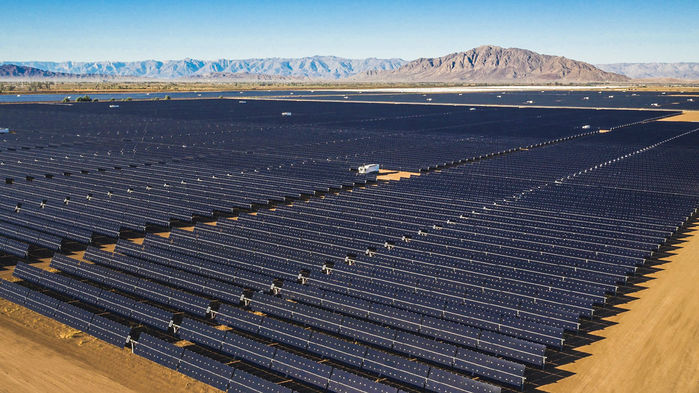De Amerikaanse staten gaan ondanks het Central Republic Gouverment Twitter Box; gelukkig hun eigen gang; zie hieronder middels een voorbeeld; het verslag van Robert F. Service. ( zou ook een voorbeeld kunnen zijn voor de diverse Europese landen ( lees hier staten ).
Giant batteries and cheap solar power are shoving fossil fuels off the grid
This month, officials in Los Angeles, California, are expected to approve a deal that would make solar power cheaper than ever while also addressing its chief flaw: It works only when the sun shines. The deal calls for a huge solar farm backed up by one of the world’s largest batteries. It would provide 7% of the city’s electricity beginning in 2023 at a cost of 1.997 cents per kilowatt hour (kWh) for the solar power and 1.3 cents per kWh for the battery. That’s cheaper than any power generated with fossil fuel.
“Goodnight #naturalgas, goodnight #coal, goodnight #nuclear,” Mark Jacobson, an atmospheric scientist at Stanford University in Palo Alto, California, tweeted after news of the deal surfaced late last month. “Because of growing economies of scale, prices for renewables and batteries keep coming down,” adds Jacobson, who has advised countries around the world on how to shift to 100% renewable electricity. As if on cue, last week a major U.S. coal company—West Virginia–based Revelation Energy LLC—filed for bankruptcy, the second in as many weeks.
The new solar plus storage effort will be built in Kern County in California by 8minute Solar Energy. The project is expected to create a 400-megawatt solar array, generating roughly 876,000 megawatt hours (MWh) of electricity annually, enough to power more than 65,000 homes during daylight hours. Its 800-MWh battery will store electricity for after the sun sets, reducing the need for natural gas–fired generators.
Precipitous price declines have already driven a shift toward renewables backed by battery storage. In March, an analysis of more than 7000 global storage projects by Bloomberg New Energy Finance reported that the cost of utility-scale lithium-ion batteries had fallen by 76% since 2012, and by 35% in just the past 18 months, to $187 per MWh. Another market watch firm, Navigant, predicts a further halving by 2030, to a price well below what 8minute has committed to.
Large-scale battery storage generally relies on lithium-ion batteries—scaled-up versions of the devices that power laptops and most electric vehicles. But Jane Long, an engineer and energy policy expert who recently retired from Lawrence Livermore National Laboratory in California, says batteries are only part of the energy storage answer, because they typically provide power for only a few hours. “You also need to manage for long periods of cloudy weather, or winter conditions,” she says.
Local commitments to switch to 100% renewables are also propelling the rush toward grid-scale batteries. By Jacobson’s count, 54 countries and eight U.S. states have required a transition to 100% renewable electricity. In 2010, California passed a mandate that the state’s utilities install electricity storage equivalent to 2% of their peak electricity demand by 2024.
Although the Los Angeles project may seem cheap, the costs of a fully renewable–powered grid would add up. Last month, the energy research firm Wood Mackenzie estimated the cost to decarbonize the U.S. grid alone would be $4.5 trillion, about half of which would go to installing 900 billion watts, or 900 gigawatts (GW), of batteries and other energy storage technologies. (Today, the world’s battery storage capacity is just 5.5 GW.) But as other cities follow the example of Los Angeles, that figure is sure to fall.










